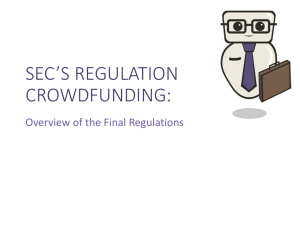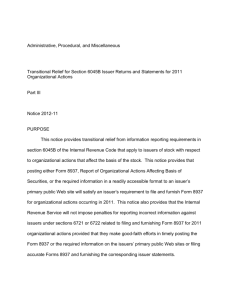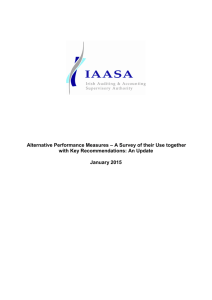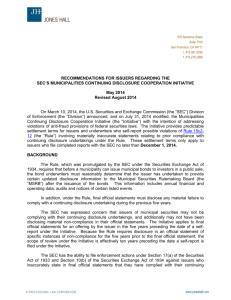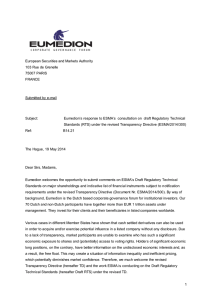View - Eumedion
advertisement
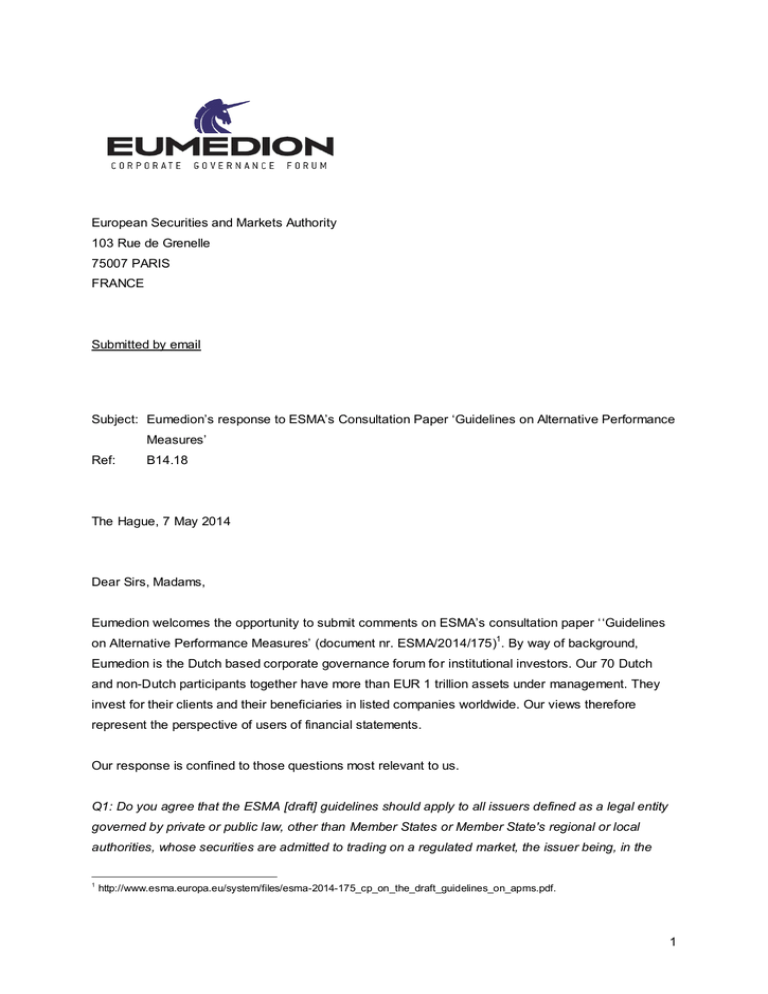
European Securities and Markets Authority 103 Rue de Grenelle 75007 PARIS FRANCE Submitted by email Subject: Eumedion’s response to ESMA’s Consultation Paper ‘Guidelines on Alternative Performance Measures’ Ref: B14.18 The Hague, 7 May 2014 Dear Sirs, Madams, Eumedion welcomes the opportunity to submit comments on ESMA’s consultation paper ‘‘Guidelines on Alternative Performance Measures’ (document nr. ESMA/2014/175)1. By way of background, Eumedion is the Dutch based corporate governance forum for institutional investors. Our 70 Dutch and non-Dutch participants together have more than EUR 1 trillion assets under management. They invest for their clients and their beneficiaries in listed companies worldwide. Our views therefore represent the perspective of users of financial statements. Our response is confined to those questions most relevant to us. Q1: Do you agree that the ESMA [draft] guidelines should apply to all issuers defined as a legal entity governed by private or public law, other than Member States or Member State's regional or local authorities, whose securities are admitted to trading on a regulated market, the issuer being, in the 1 http://www.esma.europa.eu/system/files/esma-2014-175_cp_on_the_draft_guidelines_on_apms.pdf. 1 case of depository receipts representing securities, the issuer of the securities represented regardless of the financial reporting framework they use to report? If not, why? Yes, we agree. The scope is consistent with the existing European Transparency Directive and Market Abuse Regulation which also apply to issuers whose securities are admitted to trading on a regulated market in a EU Member State. Q2: Do you agree that the ESMA [draft] guidelines should apply to APMs included in: a) financial statements prepared in accordance with the applicable financial reporting framework, that are made publicly available, and b) all other issued documents containing regulated information that are made publicly available? If not, why? Yes we agree. Regulated information other than financial statements – such as management reports, and press releases – could very well contain elements of information that are relevant for users to measure the financial performance of the issuer. In those regulated information documents issuers’ adherence to general qualitative information should also be disclosed. Q5: Do you agree with the suggested scope of the term APM as used in the [draft] guide-lines? If not, why? We agree with ESMA’ scope of the term APM that includes: (i) all measures of financial performance not specifically defined by the applicable financial reporting framework (e.g. EBIT, EBITDA, free cash flow, underlying profit, net debt, etc.); (ii) all measures designed to illustrate the physical performance of the activity of an issuer’s business (e.g. sales per square metre); and (iii) all measures disclosed to fulfil other disclosure requirements (e.g. pro-forma financial information or a profit forecast) included in public documents containing regulated information. Also, we support the approach that issuers may decide not to follow the guidelines in cases it may be clearly disproportional (e.g. in case the issuer uses company-specific APMs to show the physical context of an issuers’ businesses) or when the information provided is not useful to users. Q6: Do you believe that issuers should disclose in an appendix to the publication a list giving definitions of all APMs used? If not, why? We generally agree. It is important for users to be able to fully understand how an APM used is composed and calculated. However, we see no merit in including definitions of an APM in documents which are quite obvious and generally accepted as for instance is the case with EBITDA. More generally, issuers should be allowed to replace the list of definitions by a reference to another document which contains those definitions and is easily accessible on the issuer’s website. 2 Q7: Do you agree that issuers should disclose a reconciliation of an APM to the most relevant amount presented in the financial statements? If not, why? Yes we agree. The understandability and reliability of APMs will increase if any APM presented is accompanied by reconciliations showing how figures in the financial statements are aggregated, subtracted and/or recalculated to determine APMs. Q10: Do you agree that issuers should explain the reasons for changing the definition and/or calculation of an APM? If not, why? Yes, we agree. As a principle, in order to ensure and comparability of financial information, the definition and calculation of APMs should be consistent over time. Therefore, issuers should be rather reluctant with changing APMs. If however a definition of an APM does change, the issuer should clearly present the reasons and why the newly defined APM replacing the previous one provides better information on the performance than the previous one. Q13: Do you agree that the [draft] guidelines will improve transparency, neutrality and comparability on financial performance measures to users? If not, please provide suggestions . Yes, we believe that the draft guidelines may improve comparability and will better lead to unbiased financial information in all documents containing regulated information that are made available by issuers. If you would like to discuss our views in further detail, please do not hesitate to contact us. Our contact person is Wouter Kuijpers (wouter.kuijpers@eumedion.nl, +31 70 2040302). Yours sincerely, Rients Abma Executive Director Eumedion Zuid Hollandlaan 7 2596 AL THE HAGUE THE NETHERLANDS 3


